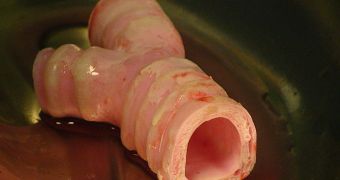In a groundbreaking medical event that will advance life science research and regenerative medicine, experts were recently able to replace a patient's windpipe with a fully synthetic trachea, that was constructed from scratch in the lab.
As a global developer, manufacturer and marketer of a broad range of such tools for regenerative medicine, Harvard Bioscience again reaffirms its position as a leading entity on this market, and as a hub for innovation in life science research.
Experts were able to use their own bioreactor – called InBreath – to develop the synthetic tissue engineered windpipe. Recently, the organ was transplanted in a patient's throat, and everything went according to plan, marking the first time such an operation is conducted.
Inside the bioreactor, experts placed a synthetic trachea scaffolding, that acted as a support structure for stem cells collected from the patient himself. The subject was suffering from late stage tracheal cancer, and needed a new windpipe as soon as possible or risk death.
Before the procedure, operating on his cancer would have been impossible. Now, he is expected to make a full recovery, after the 36-year-old was released from the hospital yesterday, July 8.
Professor Paolo Macchiarini, of the Karolinska University Hospital (KUH) and Karolinska Institutet in Sweden, conducted the team of surgeons that performed the operation, on June 9 this year. The surgery took place at KUH, in Huddinge, Stockholm.
The nanocomposite tracheal scaffold was designed and built by University College London (UCL) professor Alexander Seifalian, who was also a part of the surgery team. Harvard Bioscience provided the custom-built bioreactor.
Because the trachea is built from the patient's own stem cells, he does not need to take immunosuppressive drugs that would otherwise make him vulnerable to potentially-lethal secondary infections.
“We congratulate Professor Macchiarini and the entire scientific and surgical team on achieving this landmark in the history of regenerative medicine,” Harvard Bioscience president David Green says.
“This new type of surgery is likely to greatly expand the patient population that is treatable with organs grown in Harvard Bioscience's bioreactor. Previously, our bioreactor had been used to seed a patient's stem cells onto a donor trachea, so treatment was limited by the supply of donor organs,” he adds.
“Now that our bioreactor has proven it can be used to seed a patient's cells onto a synthetic scaffold, patients will not need to wait for a suitable donor trachea to become available,” the expert concludes.

 14 DAY TRIAL //
14 DAY TRIAL //